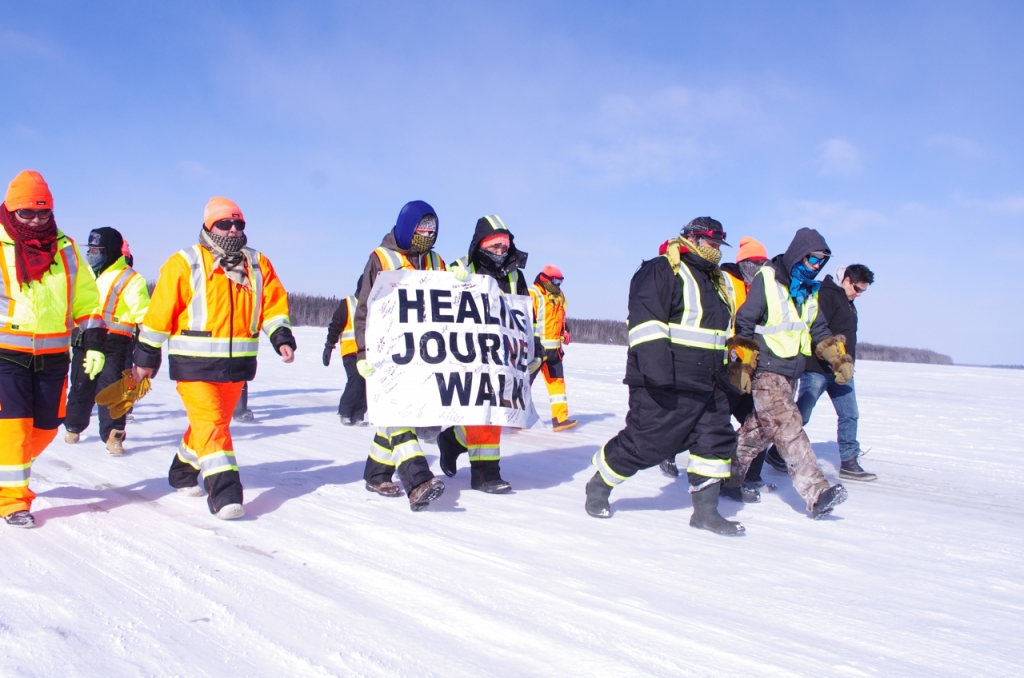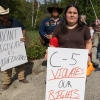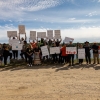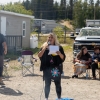The Healing Journey Home 2016 walkers were joined by Deputy Grand Chief Derek Fox, right, and a group of supporters on Feb. 29 for the final kilometre of the about 1,000 kilometre walk from Thunder Bay to Webequie. Photo by Rick Garrick.
Webequie’s Norman Shewaybick called for better First Nation health services after walking from Thunder Bay to Webequie in memory of his wife Laura, who died last October.
“My sons were there when that oxygen tank ran out (in) the nursing station,” Shewaybick says. “And I had to plead for my wife.”
Shewaybick’s wife died on Oct. 8 after being medevac’d in respiratory distress to Thunder Bay after the Webequie nursing station’ supply of oxygen ran out.
“She died in my arms,” Shewaybick says. “Four minutes later was our 26th anniversary. That’s what Health Canada gave me for an anniversary present — a dead wife.”
Keith Conn, assistant deputy minister for First Nations Inuit Health Branch, says the new federal government plans to install oxygen concentrators in northern Ontario’s First Nation communities.
“We are now instituting a whole review of all of our nursing stations in northern Ontario,” says Conn, who was in Webequie when Shewaybick and the other Healing Journey Home 2016 walkers arrived on Feb. 29. “Second to that, we are going to be purchasing and acquiring oxygen concentrators for each and every community. It’s a small step, it is only the beginning, and it is not the end. There needs to be a lot more work in terms of collaboration and in terms of short-term, intermediate and long-term action around health and wellness.”
Shewaybick says the promise to install oxygen concentrators is too late for his wife.
“When I first heard about that: ‘Why now,’ that’s what I said to myself,” Shewaybick says. “But now it feels good. It will be good for the community.”
Shewaybick, a high school teacher in Webequie, is looking for the federal government to follow through with its promise to review the nursing stations and to install oxygen concentrators.
“Hopefully those words that they said can come true for others to use, for others to live,” Shewaybick says. “And it’s one step ahead now.”
Nickel Belt MPP France Gélinas questioned why oxygen concentrators were not installed in nursing stations previously.
“How come this was not done 25 years ago — oxygen concentrators have been around for a long time,” says the health critic and Aboriginal critic for the provincial New Democratic Party. “People who have lung issues have them in their houses. They are not expensive, they are easy to operate, they require minimal maintenance. How come they have not seen fit to make sure that every nursing station has one is beyond me.”
Gélinas says she has visited most of the nursing stations across Ontario.
“You see the difference in the people that work there,” Gélinas says. “Some of them are among the best nurse practitioners that I know. They are qualified, they are very knowledgeable, and they have lots of skills. But when you don’t give them the tools, the supplies to do their work, then it’s all for none. The nursing stations are ill equipped. They often have to wait a long time to re-supply. They are so stretched for resources that this woman died due to a lack of oxygen. This is unbelievable.”
Shewaybick, his sons Leon, Erick and Brandon and a group of supporters began the Healing Journey Home 2016 walk on Feb. 12 at the Thunder Bay Regional Health Sciences Centre. They carried an oxygen bottle to honour Laura’s memory with them for the entire journey and deposited it at the doors of the Webequie nursing station after a ceremony.
“This journey, she was there,” Shewaybick says, noting his late wife’s presence on the walk. “Now that I got that oxygen tank to the nursing station, my promise to her has been fulfilled. And it’s time for her to rest in peace. Her journey has ended. I’m home; the healing begins.”
Webequie Chief Cornelius Wabasse says the Healing Journey Home 2016 will continue by working together with government representatives.
“We are very grateful that we are going to be working together to take the next step on this healing journey, which is working together and strategizing on how we can improve the services for our community,” Wabasse says. “I’m looking forward to the next steps. Hopefully all of us First Nations can get together at the same time and work on the issues and bring them up to par for our communities.”
Wabasse has been encouraged by the election of the new federal government on Oct. 19.
“It is very encouraging to hear them say that they are going to have a new government-to-government relationship on all issues, not just on health issues,” Wabasse says, noting he has been talking with the federal government on housing and infrastructure as well as health. “That is what we would like to see, is better services for our communities. It is encouraging that the new federal government will work with us closely on these issues.”
Deputy Grand Chief Derek Fox says Nishnawbe Aski Nation’s thoughts have been with Shewaybick and his family throughout the Healing Journey Home 2016 walk.
“We are pleased to greet them on their arrival home and honour their efforts to raise awareness about the lack of health services in remote First Nations,” Fox says. “The tragic circumstances that led to this walk is a sad example of how the health care system is failing First Nations. This has led to our declaration of a Health and Public Health Emergency and our call to the provincial and federal governments to commit to a plan of action to begin to address this crisis.”
NAN and representatives of the Sioux Lookout Area Chiefs Committee on Health declared a Health and Public Health Emergency for First Nations in the Sioux Lookout region and across NAN territory on Feb. 24 to address urgent and long-standing health issues caused by inequality of health and health care services.
More than 14 walkers participated in Healing Journey Home 2016, averaging about 120 kilometres per day along Highway 17 to Ignace, Highway 599 to Pickle Lake, the Pickle Lake North Road and the winter road to Webequie.



















I am the product, evolution of many thousands of years as are you. I grew up on the land in the remote far north of Ontario following in the footsteps of my...
One of the most beautiful serene places I’ve ever visited was on the banks of the Opinagau River in northern Ontario, just near the corner of land where...